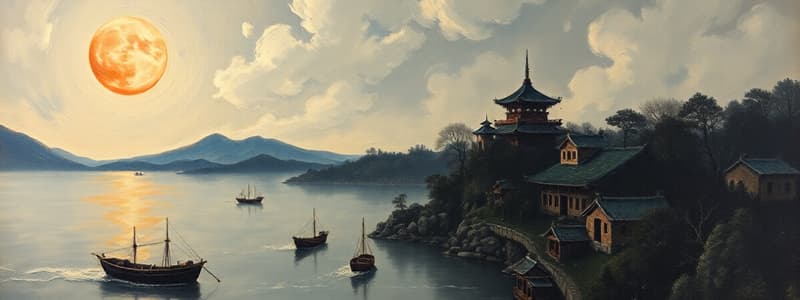Podcast
Questions and Answers
Which of the following was NOT a factor in Japan's expansionist foreign policy?
Which of the following was NOT a factor in Japan's expansionist foreign policy?
- A decrease in exports
- A desire for resources like timber and coal
- Increased trade with the United States (correct)
- Militarist and nationalist thinking
The Japanese invasion of Manchuria occurred after fighting broke out between Japanese and Chinese forces near Beijing in 1937.
The Japanese invasion of Manchuria occurred after fighting broke out between Japanese and Chinese forces near Beijing in 1937.
False (B)
What was the name of the sphere of influence that Japan wanted to create in Asia?
What was the name of the sphere of influence that Japan wanted to create in Asia?
Greater East Asia Co-Prosperity Sphere
The Tripartite Axis Pact, signed in September 1940, agreed that Germany and Italy would dominate __________ and leave __________ to Japan.
The Tripartite Axis Pact, signed in September 1940, agreed that Germany and Italy would dominate __________ and leave __________ to Japan.
What event led to the USA and Britain freezing Japanese assets?
What event led to the USA and Britain freezing Japanese assets?
The war between Japan and China in 1937 was a planned war by the Japanese.
The war between Japan and China in 1937 was a planned war by the Japanese.
Which country had control over Indochina before the Japanese invasion in 1940?
Which country had control over Indochina before the Japanese invasion in 1940?
Match the following events with their corresponding dates:
Match the following events with their corresponding dates:
What was the primary goal of Japan's attack on Pearl Harbor?
What was the primary goal of Japan's attack on Pearl Harbor?
The Tripartite Pact united Germany, Italy, and the United States against common threats.
The Tripartite Pact united Germany, Italy, and the United States against common threats.
What was the name of the German strategy to defeat Britain?
What was the name of the German strategy to defeat Britain?
In September 1939 Germany invaded _______, which was the start of the war in Europe.
In September 1939 Germany invaded _______, which was the start of the war in Europe.
What was the impact of the Battle of Britain?
What was the impact of the Battle of Britain?
The US imposed a complete trade embargo on Japan, including oil, before the attack on Pearl Harbor.
The US imposed a complete trade embargo on Japan, including oil, before the attack on Pearl Harbor.
Match the following invasion with their time period:
Match the following invasion with their time period:
What was the name of the German air force during the Battle of Britain?
What was the name of the German air force during the Battle of Britain?
Flashcards
Japan's Economic Crisis in the 1930s
Japan's Economic Crisis in the 1930s
The economic hardship in Japan during the 1930s, characterized by declining exports and rising unemployment, fueled the rise of militarist and nationalist forces who sought expansionist policies.
Why was Manchuria appealing to Japan?
Why was Manchuria appealing to Japan?
Manchuria, a region rich in resources like timber, coal, iron, and rice, was seen as an attractive target for Japanese expansion due to its potential to solve Japan's resource shortage and provide a market for its manufactured goods.
The Kwantung Army and Japan's Government
The Kwantung Army and Japan's Government
The Kwantung Army, a Japanese military force stationed in Manchuria, often took independent actions, like the invasion of Manchuria in 1931, which the Japanese government had to reluctantly support.
The Second Sino-Japanese War
The Second Sino-Japanese War
Signup and view all the flashcards
Japan's "New Order in Asia"
Japan's "New Order in Asia"
Signup and view all the flashcards
The USA's Response to Japan's Expansion
The USA's Response to Japan's Expansion
Signup and view all the flashcards
Japan's Expansion to South East Asia
Japan's Expansion to South East Asia
Signup and view all the flashcards
The Tripartite Pact
The Tripartite Pact
Signup and view all the flashcards
US policy shift towards Japan (1938 onwards)
US policy shift towards Japan (1938 onwards)
Signup and view all the flashcards
What was the Tripartite Pact?
What was the Tripartite Pact?
Signup and view all the flashcards
US Economic Sanctions on Japan (1939-1941)
US Economic Sanctions on Japan (1939-1941)
Signup and view all the flashcards
What happened at Pearl Harbor?
What happened at Pearl Harbor?
Signup and view all the flashcards
What did the Hossbach Memorandum reveal about Germany's intentions?
What did the Hossbach Memorandum reveal about Germany's intentions?
Signup and view all the flashcards
What event started WWII in Europe?
What event started WWII in Europe?
Signup and view all the flashcards
How did France fall in WWII?
How did France fall in WWII?
Signup and view all the flashcards
Why did Germany change its strategy after the Battle of Britain?
Why did Germany change its strategy after the Battle of Britain?
Signup and view all the flashcards
Study Notes
Japan's Expansionist Policies
- Japan's domestic crises (e.g., economic downturn, unemployment) fueled expansionist policies.
- Manchuria's resources (timber, coal, iron, rice) and market for Japanese goods were attractive.
- The Japanese government often had to accede to the Kwantung Army's decisions in China.
- The Sino-Japanese War (1937-1945) began with clashes near Beijing, spreading to Shanghai and Nanjing, becoming a costly, large-scale conflict.
- Japan aimed to establish a "Greater East Asia Co-Prosperity Sphere."
- In 1940, Japan invaded northern Indochina to hinder China's fuel and arms imports.
- Pressured France to allow Japanese troops and airfields in Indochina.
- The Tripartite Pact (1940) with Germany and Italy formalized their agreement to divide the world's control.
Japanese Actions and Reactions
- Japan's ambitions expanded to Southeast Asia by 1940.
- The US became increasingly concerned about Japan's ambitions, leading to restrictions and the freezing of Japanese assets.
- Japan's attack on Pearl Harbor (December 7, 1941) aimed to cripple the US Pacific Fleet.
- The attack triggered the entry of the US into World War II.
Global Context of Japan's Actions
- The US shifted from isolationism to opposing the Tripartite Pact.
- The global conflict between European powers played into Japan's aspirations in Asia.
- Japan's actions in Asia were viewed as part of a broader global conflict.
European Front Developments
- Germany invaded Poland (1939), followed by Denmark and Norway (1940).
- France was defeated (1940).
- The Battle of Britain (1940) halted German air superiority.
- Italy also launched campaigns in the Mediterranean, failing to entirely conquer North Africa or Greece.
- Germany invaded the Soviet Union in 1941 (Operation Barbarossa).
Studying That Suits You
Use AI to generate personalized quizzes and flashcards to suit your learning preferences.




